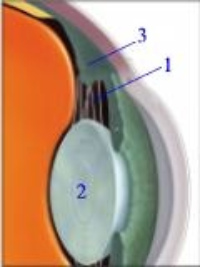|
Presbyopia?
You used to wear glasses or contact lenses with no problems reading up close. Now you notice that you can’t read up close with your glasses or contact lenses. Has your eye doctor told you that you have to wear reading glasses or need to use bifocals? Are you over forty years of age? You have Presbyopia. In order to view the content, you must install the Adobe Flash Player. Please click here to get started.
What Is Presbyopia?
Presbyopia is a normal aging change. It results from the gradual decrease in focusing ability expected with age. However, you may feel as if your difficulty reading small print up close started all of a sudden. 
In the above diagram, the following structures are represented by the numbers: 1. Zonules 2. Crystalline Lens 3. Ciliary Body The zonules are like elastic bands that shorten when you are focusing on a near object making the crystalline lens short and fat. When you focus far away, the zonules stretch out and elongate making the crystalline lens taller and skinnier. After age 40, these zonules become less elastic and less pliable to shorten and focus at near. Sometimes the decrease in elasticity of the zonules is gradual and hard to discern. Other times it seems like it happens all of a sudden! What are the symptoms?
You will notice difficulty reading up close only when your focusing ability is insufficient for your individual needs. If you spend the majority of your work day in front of a computer, for example, you may notice your difficulty reading before someone who does work mostly at a distance. When you suffer from Presbyopia you may notice the following symptoms up close: How is it diagnosed?
Presbyopia is diagnosed with a complete eye examination which includes the following: The add power or the strength of a bifocal will be calculated based on your focusing ability, your near work demands, and your typical working distance. It is important for you to tell your eye doctor what medications you use since decreased focusing ability can be a side effect of certain drugs such as: What options do you have to treat Presbyopia?
The two most common treatment options for Presbyopia include glasses and contact lenses. All the types of corrections for Presbyopia require some visual compromise and adaptation as opposed to having normal focusing ability. If you prefer to use glasses only, your options include: The bottom is basically a magnifying power that is added to your distance to help you see at near. Bifocal glasses come in a variety of designs and sizes (for example, a flat line, a curved line, etc.) If you become accustomed to one type of bifocal, it will be difficult for you to get used to a different kind. The kind you choose should be selected on your individual near work demands. If you work in front of a computer for extended periods of time, a bifocal to help you see far and near may not be adequate. You may find that you have to get close to the computer to see better and that your neck may be bothering you as a result. In that case, consider choosing one of the following choices: Multifocal contact lenses offer an excellent option for those who need good depth perception as well as those who would like to see at intermediate distances such as computer distance. Manufacturers have been continually developing new multifocal contact lenses with better materials and designs, available in both soft and rigid gas permeable materials. Other contact lens options include monovision or using distance contact lenses with reading glasses over the lenses. Consult your eye practitioner to find out if you are a good candidate for these lenses. |




